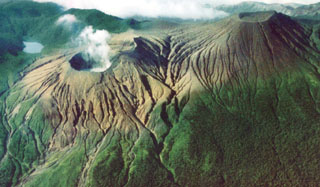Report on Rincon de la Vieja (Costa Rica) — 28 September-4 October 2011
Smithsonian Institution / US Geological Survey
Weekly Volcanic Activity Report, 28 September-4 October 2011
Managing Editor: Sally Sennert.
Please cite this report as:
Global Volcanism Program, 2011. Report on Rincon de la Vieja (Costa Rica) (Sennert, S, ed.). Weekly Volcanic Activity Report, 28 September-4 October 2011. Smithsonian Institution and US Geological Survey.
Rincon de la Vieja
Costa Rica
10.83°N, 85.324°W; summit elev. 1916 m
All times are local (unless otherwise noted)
On 30 September, OVSICORI-UNA reported phreatic eruptions from Rincón de la Vieja's active crater during the previous six weeks. A well-documented event on 16 September ejected sediment that covered sections of the upper N walls. Some of the material was washed down the flanks and caused changes in water quality along the main creeks and major rivers up to 18 km away from the source. The death of several fish species was noted the next day and sediment deposits 10-15 cm deep were sampled 2 km N of the active crater. Scientists conducting fieldwork during 27-29 September observed that the hot lake was convecting and grayish in color due to the suspended sediments. Preliminary deformation and temperature measurements did not indicate any significant changes.
Geological Summary. Rincón de la Vieja, the largest volcano in NW Costa Rica, is a remote volcanic complex in the Guanacaste Range. The volcano consists of an elongated, arcuate NW-SE-trending ridge constructed within the 15-km-wide early Pleistocene Guachipelín caldera, whose rim is exposed on the south side. Sometimes known as the "Colossus of Guanacaste," it has an estimated volume of 130 km3 and contains at least nine major eruptive centers. Activity has migrated to the SE, where the youngest-looking craters are located. The twin cone of Santa María volcano, the highest peak of the complex, is located at the eastern end of a smaller, 5-km-wide caldera and has a 500-m-wide crater. A Plinian eruption producing the 0.25 km3 Río Blanca tephra about 3,500 years ago was the last major magmatic eruption. All subsequent eruptions, including numerous historical eruptions possibly dating back to the 16th century, have been from the prominent active crater containing a 500-m-wide acid lake located ENE of Von Seebach crater.
Source: Observatorio Vulcanologico y Sismologico de Costa Rica-Universidad Nacional (OVSICORI-UNA)

